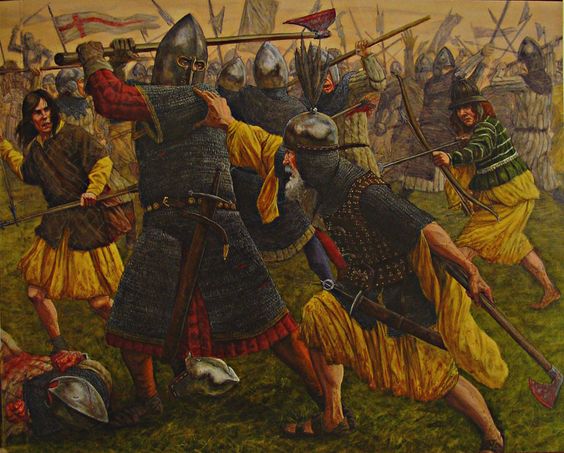Irish Gallowglass warrior and Irish Kern, Marc Grunert
The most prominent feature in the pretty town of Ballyshannon in south Donegal is a tall, ornate Victorian building which for very many decades has had the name of the proprietor prominently displayed across its frontage – Gallogley. It is an unusual surname but it is a vivid reminder of the crucial role played by a fresh group of newcomers to Ireland in the late Middle Ages.
The ability of Gaelic lords to win back lost territory is in part explained by their employment of gallóglaigh, which literally means ‘young foreign warriors’. Confusingly, the annalists referred both to the Vikings and the English as the ‘Gall’, the foreigners. The word ‘gallóglaigh’ was anglicised by the colonists in Ireland as ‘gallowglasses’. Gallowglasses were of mixed Viking-Gaelic blood, who after the king of Scotland had broken any remaining power the King of Norway had in his land at the Battle of Largs in 1263, sought employment for their arms in Ireland. When Robert Bruce, King of Scotland, brought over reinforcements to help his brother Edward in 1316 the annals noted that he had with him a great force of gallowglasses. Thereafter more and more of these fighting men came south to Ireland from the Western Isles.
A high proportion of the gallowglasses were descendants of a Viking Lord of the Isles known as Somerled, which means ‘summer wanderer’. These men broke up into warring clans and it was often those who were defeated in these petty conflicts that came to Ireland to seek their fortunes. In Spring they would plough their small fields, plant their seed oats and then gather their weapons and armour to row and sail across the North Channel to Ulster, there to offer their services to the highest bidder. Previously driven into remote corners of the island, Gaelic lords were taking advantage of the growing weakness of the Lordship of Ireland by campaigning to recover the lands lost by their ancestors. Many were eager to employ these warriors from the Isles. The O’Donnells, the ruling family of the lordship of Tír Conaill in what is now Co Donegal, were among the first to engage gallowglasses: instead of fighting the English, they used them to drive the O’Neills out of the fertile country around the Foyle. Their leading gallowglass clan, the MacSweeneys, at first were paid in kind:
This is how the levy was made; two gallowglasses for each quarter of land, and two cows for each gallowlass deficient, that is, one cow for the man himself and one for his equipment. And Clann Sweeney say they are responsible for these as follows, that for each man equipped with a coat of mail and a breastplate, another should have a jack and a helmet: that there should be no forfeit for a helmet deficient except the gallowglass’s brain (dashed out for want of it).
Each gallowglass had a manservant to carry his coat of mail and a boy who looked after the food and did the cooking. He fought in traditional Viking style, wielding an axe or a spar, ‘much like the axe of the Tower’ as Sir Anthony St Leger described it. St Leger who faced gallowglasses in battle on many an occasion, believed that
These sort of men be those that do not lightly abandon the field, but bide the brunt to the death.
Gallowglass fighting men stiffened the ranks of native Irish foot soldiers, or kerne, who, according to St Leger:
Fight bare naked, saving their shirts to hide their privates; and those have darts and short bows: which sort of people be both hardy and deliver to search woods and marshes, in which they be hard to be beaten.
When the summer season of fighting was over, these Scottish warriors – provided they had survived – received their pay, mostly in the form of butter and beef, and sailed back to the Isles in time to reap, thrash and winnow their harvests. In time gallowglasses acquired land as a more secure source of income. The MacSweeneys got territory in Donegal and divided into three clans: MacSweeney na Doe (na Doe comes from na d’Tuath, meaning ‘of the Tribes’) in the Rosses and around Creeshlough; MacSweeney Fanad, on the peninsula named after them just west of Lough Swilly; and MacSweeney Banagh in the vicinity of Slieve League.
A branch of the MacDonnells, settled in the lands about Ballygawley in Co Tyrone, became a powerful arm of the O’Neills of Tír Eóghain in their struggle to become the leading Gaelic rulers of Ireland. Another cohort of MacDonnells, the lords of Kintyre and Islay, made their home in the Glens of Antrim.
During the fourteenth century bands of gallowglasses spread out all over Gaelic Ireland to seek employment for heir arms. These men from Innse Gall – the Irish name for the Hebrides – bore surnames now familiar all over the country including MacCabe, MacRory, MacDougall, MacDowell and MacSheehy. They were to help Gaelic lords bring the Lordship of Ireland to its knees.
